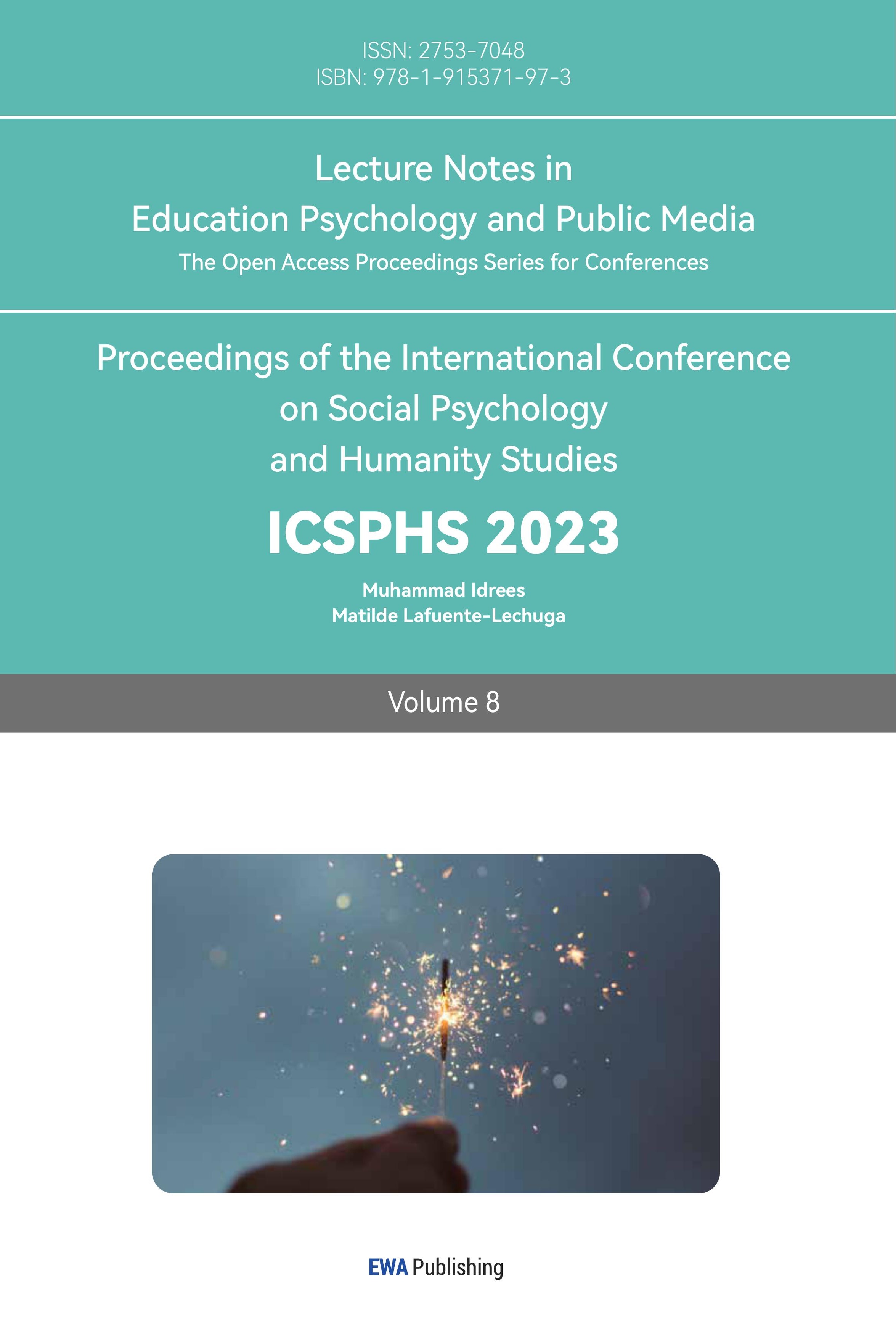References
[1]. Gramlich, J. (2022. What the data says about gun deaths in the U.S. Pew Research Center. Retrieved from: https://policycommons.net/artifacts/2232815/what-the-data-says-about-gun-deaths-in-the-us/2990720/ on 05 Mar 2023. CID: 20.500.12592/d8nqw9
[2]. Sandy Hook Promise. (2023). 16 Facts About Gun Violence And School Shootings. Sandy Hook Promise. Retrieved from:https://xueshu.studiodahu.com/scholar?hl=zhCN&as_sdt=0%2C5&q=16+Facts+About+Gun+Violence+And+School+Shootings&btnG=
[3]. Homicide Rate. (2020). New CDC/NCHS Data Confirm Largest One-Year Increase in U.S. Retrieved from: https://www.sciencedirect.com/science/article/pii/S0091743522002912
[4]. Barry, C. L., McGinty, E. E., Vernick, J. S., Webster, D. W. (2015). Two years after Newtown—public opinion on gun policy revisited. Preventive Medicine, 79, 55–58.
[5]. Cukier, W., Eagen, S. A. (2018). Gun violence. Current Opinion in Psychology, 19, 109-112.
[6]. Crifasi, C. K., Ward, J. A., McGinty, E. E., Webster, D. W., & Barry, C. L. (2021). Public opinion on gun policy by race and gun ownership status. Preventive Medicine, 149, 106607.
[7]. Masters, J. (2022). U.S. Gun Policy: Global Comparisons. Council on Foreign Relations Press.
[8]. BBC News. (2023). Gun violence in US and what the statistics tell us. BBC Press.
[9]. Luca, M., Malhotra, D., Poliquin, C. (2020). The impact of mass shootings on gun policy. Journal of Public Economics, 181, 104083.
[10]. Newman, B. J., Hartman, T. K. (2017). Mass Shootings and Public Support for Gun Control. British Journal of Political Science, 49(4), 1527–1553.
[11]. McGinty, Webster, D. W., Barry, C. L. (2013). Effects of News Media Messages About Mass Shootings on Attitudes Toward Persons With Serious Mental Illness and Public Support for Gun Control Policies. The American Journal of Psychiatry, 170(5), 494–501.
[12]. Fridel, E. E. (2020). Comparing the Impact of Household Gun Ownership and Concealed Carry Legislation on the Frequency of Mass Shootings and Firearms Homicide. Justice Quarterly, 38(5), 892-915.
[13]. American Psychological Association. (2013). Gun Violence: Prediction, Prevention, and Policy. PsycEXTRA Dataset Press.
[14]. Post, Mason, M., Singh, L. N., Wleklinski, N. P., Moss, C. B., Mohammad, H., Issa, T. Z., Akhetuamhen, A., Brandt, C. A., Welch, S. B., Oehmke, J. F. (2021). Impact of Firearm Surveillance on Gun Control Policy: Regression Discontinuity Analysis. JMIR Public Health and Surveillance, 7(4), e26042–e26042.
Cite this article
Hu,J. (2023). The Gun Policy, Crime Rate, and Public Attitudes In the U.S.. Lecture Notes in Education Psychology and Public Media,8,306-310.
Data availability
The datasets used and/or analyzed during the current study will be available from the authors upon reasonable request.
Disclaimer/Publisher's Note
The statements, opinions and data contained in all publications are solely those of the individual author(s) and contributor(s) and not of EWA Publishing and/or the editor(s). EWA Publishing and/or the editor(s) disclaim responsibility for any injury to people or property resulting from any ideas, methods, instructions or products referred to in the content.
About volume
Volume title: Proceedings of the International Conference on Social Psychology and Humanity Studies
© 2024 by the author(s). Licensee EWA Publishing, Oxford, UK. This article is an open access article distributed under the terms and
conditions of the Creative Commons Attribution (CC BY) license. Authors who
publish this series agree to the following terms:
1. Authors retain copyright and grant the series right of first publication with the work simultaneously licensed under a Creative Commons
Attribution License that allows others to share the work with an acknowledgment of the work's authorship and initial publication in this
series.
2. Authors are able to enter into separate, additional contractual arrangements for the non-exclusive distribution of the series's published
version of the work (e.g., post it to an institutional repository or publish it in a book), with an acknowledgment of its initial
publication in this series.
3. Authors are permitted and encouraged to post their work online (e.g., in institutional repositories or on their website) prior to and
during the submission process, as it can lead to productive exchanges, as well as earlier and greater citation of published work (See
Open access policy for details).
References
[1]. Gramlich, J. (2022. What the data says about gun deaths in the U.S. Pew Research Center. Retrieved from: https://policycommons.net/artifacts/2232815/what-the-data-says-about-gun-deaths-in-the-us/2990720/ on 05 Mar 2023. CID: 20.500.12592/d8nqw9
[2]. Sandy Hook Promise. (2023). 16 Facts About Gun Violence And School Shootings. Sandy Hook Promise. Retrieved from:https://xueshu.studiodahu.com/scholar?hl=zhCN&as_sdt=0%2C5&q=16+Facts+About+Gun+Violence+And+School+Shootings&btnG=
[3]. Homicide Rate. (2020). New CDC/NCHS Data Confirm Largest One-Year Increase in U.S. Retrieved from: https://www.sciencedirect.com/science/article/pii/S0091743522002912
[4]. Barry, C. L., McGinty, E. E., Vernick, J. S., Webster, D. W. (2015). Two years after Newtown—public opinion on gun policy revisited. Preventive Medicine, 79, 55–58.
[5]. Cukier, W., Eagen, S. A. (2018). Gun violence. Current Opinion in Psychology, 19, 109-112.
[6]. Crifasi, C. K., Ward, J. A., McGinty, E. E., Webster, D. W., & Barry, C. L. (2021). Public opinion on gun policy by race and gun ownership status. Preventive Medicine, 149, 106607.
[7]. Masters, J. (2022). U.S. Gun Policy: Global Comparisons. Council on Foreign Relations Press.
[8]. BBC News. (2023). Gun violence in US and what the statistics tell us. BBC Press.
[9]. Luca, M., Malhotra, D., Poliquin, C. (2020). The impact of mass shootings on gun policy. Journal of Public Economics, 181, 104083.
[10]. Newman, B. J., Hartman, T. K. (2017). Mass Shootings and Public Support for Gun Control. British Journal of Political Science, 49(4), 1527–1553.
[11]. McGinty, Webster, D. W., Barry, C. L. (2013). Effects of News Media Messages About Mass Shootings on Attitudes Toward Persons With Serious Mental Illness and Public Support for Gun Control Policies. The American Journal of Psychiatry, 170(5), 494–501.
[12]. Fridel, E. E. (2020). Comparing the Impact of Household Gun Ownership and Concealed Carry Legislation on the Frequency of Mass Shootings and Firearms Homicide. Justice Quarterly, 38(5), 892-915.
[13]. American Psychological Association. (2013). Gun Violence: Prediction, Prevention, and Policy. PsycEXTRA Dataset Press.
[14]. Post, Mason, M., Singh, L. N., Wleklinski, N. P., Moss, C. B., Mohammad, H., Issa, T. Z., Akhetuamhen, A., Brandt, C. A., Welch, S. B., Oehmke, J. F. (2021). Impact of Firearm Surveillance on Gun Control Policy: Regression Discontinuity Analysis. JMIR Public Health and Surveillance, 7(4), e26042–e26042.









